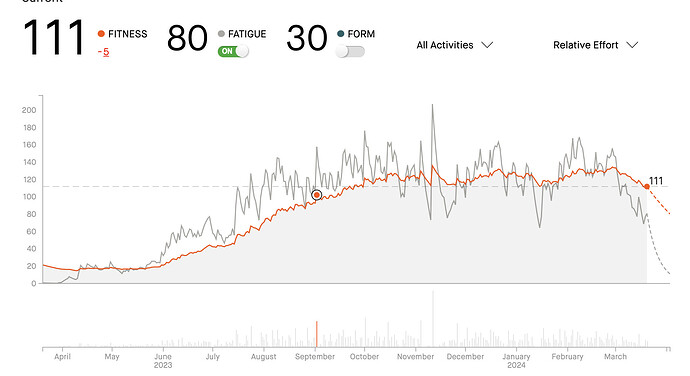Hello! I have been an active strava user for a few years now and suffered my third ACL tear in Feb of 2023. I started building back from nothing and gradually saw my fitness score rise every day. That lasted all the way up until Feb of this year when things started getting inconsistent. I know I can’t keep increasing fitness without some plateau and down weeks, but it seemed so sudden and now it seems my fitness score is going in the other direction even though my HR is lower for the same activities, I am PRing segments and completing the same mileage in less time. Strava simply says because my HR isn’t as high, it’s calculating my relative effort as much lower which causes fitness to either not change or decrease. On intervals, it appears my graph is still on a steady incline which was refreshing to see. Can someone shed some light into how much these data points should be read into? I’d love to just ignore them and know I’m getting fitter based on feel alone, but sometimes the data gets to you!
The Fitness number isn’t telling you anything regarding performance. It only tells you what your Acute Training Load is.
Questions on this same topic are flooding the forum. The Fitness number is limited by your available training time, your performance isn’t.
Do you have wattage data?
not a bad idea ![]()
that graph is used mainly for planning and scheduling and even that only roughtly
it is based on tss and tss is based on your power (hr probably if no power is present) but it does not take into accout your form per se but uses % of your ftp, meaning whatever your fitness is, it is only important for how long and at what % of your ftp did you ride, ofc if your ftp is lower the TSS score is still the same meaning again, it is not reflecting your fitness. It just shows how much work you have done on a daily rolling avg.
don’t know what calcs straba is using but generally 111 of fitness is amazingly high and is close to very trained athletes. That score will always plateau around 90-120 bc of your time and fatigue limit, to get a score of around 100 you need more or less constant 15hrs weeks with progresssing intensity.
buy a power meter, if you have power diesdrepency after an ACL, dual sided power meter like assioma pedals is strongly sugeste and a proper bikefit.
lower hr can mean you are more fit but seeing how motivated you are it can means you are just very tired. maybe try to incorporate a recovery week (At least one every 4th week)
We are not strava masters ![]() and it is not clear what exact calculation they are using, but for sure intervals fitness graph is using standard rolling avg etc. So you should trust intervals more.
and it is not clear what exact calculation they are using, but for sure intervals fitness graph is using standard rolling avg etc. So you should trust intervals more.
if it is hr based, probably you should do a proper lthr test and set your zones accordingly.
If you are after third ACL, please relax. Your health is most important, no graph will tell you if you are better or worse. If you get better times, that mieans more. But anyway I would focus much more on recovery and takitn some fun from those rides.
btw. quick calc, if I remember corretly the rolling avg is from 50-60 days, so you need 50 days at least of consecutive load of 110tss that means roughly 17hrs at 65% a week (or 7hrs of z4 but that is impossible to ride) , week by week (assuming ftp and hr zones are correct). As an example with 340 peak ftp and 15-18 hrs a week i topped last season at 95 fitness and was destroyed after that season.
Not really as I am running
that’s helpful info, thanks! I’m a little over a year post op and have been running 40-55 miles consistently on trail since probably september 2023. currently have averaged 8.5-10 hours of training per week. no power meter just my heart rate monitor on my watch. definitely have a lot of fun in training and training for big races this year, was just concerned that with my all my training suddenly i was going in the wrong direction fitness wise even those my performance metrics seemed to be improving
That’s helpful, thanks, I take it as I need to increase stimulus on the body to see change whether that’s increasing intensity or time

